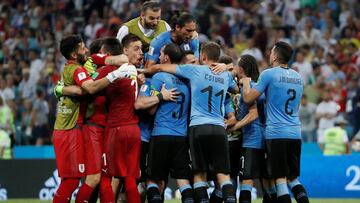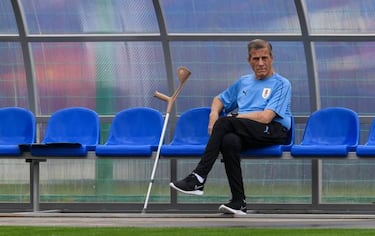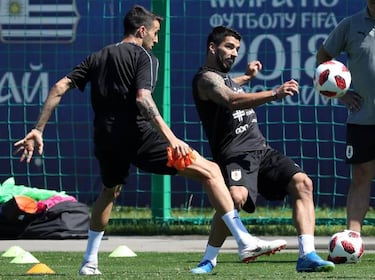Uruguay punch above their weight on world stage...yet again
With similar accents and culture, there is little that annoys your average Uruguayan more than being mistaken for an Argentine next door.

With similar accents and culture, there is little that annoys your average Uruguayan more than being mistaken for an Argentine next door. No one, however, is confusing them at the World Cup.
Argentina, with a population of more than 40 million, have gone home after a shambolic campaign that saw just one last-gasp win in four matches, a miserable Lionel Messi failing again on the big stage, and a wobbly defence beaten nine times.
Uruguay, with 3.3 million people, are into a quarter-final with Argentina's conquerors France after four straight wins including a stunning 2-1 knockout victory over Cristiano Ronaldo's Portugal.
So with such a small population pool, how can 'La Celeste' (The Light Blues) be so consistently good?
La Celeste entrena en una de las canchas del complejo en Nizhny Novgorod y prepara el partido del viernes ante @equipedefrance.#ElEquipoQueNosUne pic.twitter.com/Sfm1A8UVMu
— Selección Uruguaya (@Uruguay) July 4, 2018
Their success, as any fan knows, is no new phenomenon.
Uruguay won the inaugural World Cup in their capital Montevideo in 1930 and upset hosts Brazil to lift it again in 1950 in front of a crowd of 205,000, the largest to ever watch a match anywhere, in a game more known as the 'Maracanazo'.
That early success was thanks in part to enlightened social inclusion policies. While South American neighbours were restricting soccer to a European descendant elite, Uruguay's star was Jose Andrade, the son of an African-born slave.
The modern generation have not yet won a World Cup, but have been no slackers either. They reached the semi-finals in 2010 - the furthest they had got since 1970 - and the second round at the last tournament.
Uruguay have also won the regional Copa Americas 15 times.
"The reasons are many, but all related to one big thing: the entire country is dedicated to soccer," said one Uruguayan, Javier Borkenztain, discussing the phenomenon on social media.

Highest success per capita
Beyond the national obsession with soccer - notable even in comparison with the passions on display in neighbouring Brazil and Argentina - there is the question of stability at the helm.
Their current coach Oscar Tabarez, for example, has been in charge for 12 years and is at his third World Cup of that spell. Locals call him 'El Maestro' (The Teacher).
Then there is a meticulous youth system that gets children organised and enthused from aged four.

Furthermore, Uruguay has a highly-developed coaching network that is not shy to move talent on to Europe fast, which the national team can then draw back on.
All-time top scorer Luis Suarez headed to the Netherlands aged 19 to join Groningen, before going on to Ajax, Liverpool and Barcelona.
Then there is a more nebulous factor - the famous Uruguayan "Garra Charrua" (Charrua Claw), meaning a fighting spirit and intensity said to enable the team to play above its real level.
"Uruguayan football is just an extension of the Uruguayan mindset of never backing down against the world even when success seems unlikely," said Fernando Alberto, a Brazilian who has visited Uruguay, musing online on the causes of their standing in the soccer world.

"Uruguay has half the population of the city of Rio de Janeiro. It is really hard to understand why. The thing is that they just love the sport like very few do."
Unusually, Uruguay are not the smallest nation among the 32 who made it to Russia. That distinction went to Iceland, another team who have taken the "garra" concept to new levels, albeit with a Viking twist, and whose own population of 340,000 would fit into a suburb of Montevideo.
But while Iceland and Uruguay fans may feel like brothers in some ways, one set are back home and another is converging on Nizhny Novgorod for Friday's showdown with France.
Related stories
And if soccer status were determined by success per capita, even Iceland could not come near Uruguay's undisputed crown.
"We give our lives for every ball," said midfielder Lucas Torreira. "This country is very small but it has a huge heart."